
Monmouth is a town and community in Wales. It is situated where the River Monnow joins the River Wye, two miles from the Wales–England border. Monmouth is 30 miles (50 km) northeast of Cardiff, and 113 miles (182 km) west of London. It is within the Monmouthshire local authority, and the parliamentary constituency of Monmouth. The population in the 2011 census was 10,508, rising from 8,877 in 2001. Monmouth is the historic county town of Monmouthshire although Abergavenny is now the county town.

Chepstow is a town and community in Monmouthshire, Wales, adjoining the border with Gloucestershire, England. It is located on the tidal River Wye, about 2 miles (3 km) above its confluence with the River Severn, and adjoining the western end of the Severn Bridge. It is the easternmost settlement in Wales, situated 16 miles (26 km) east of Newport, 28 miles (45 km) east-northeast of Cardiff, 18 miles (29 km) northwest of Bristol and 110 miles (180 km) west of London.

Tintern is a village in the community of Wye Valley, on the west bank of the River Wye in Monmouthshire, Wales, close to the border with England, about 5 miles (8.0 km) north of Chepstow. It is popular with tourists, in particular for the scenery and the ruined Tintern Abbey. Modern Tintern has been formed through the coalescence of two historic villages; Tintern Parva, forming the northern end of the village, and Chapel Hill, which forms the southern end. The village is designated as a Conservation Area.
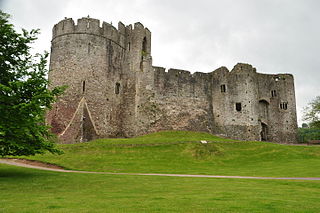
Chepstow Castle at Chepstow, Monmouthshire, Wales is the oldest surviving post-Roman stone fortification in Britain. Located above cliffs on the River Wye, construction began in 1067 under the instruction of the Norman Lord William FitzOsbern. Originally known as Striguil, it was the southernmost of a chain of castles built in the Welsh Marches, and with its attached lordship took the name of the adjoining market town in about the 14th century.
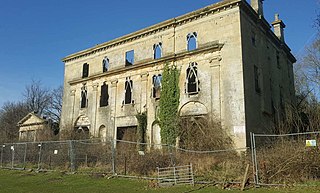
Piercefield House is a largely ruined neo-classical country house near St Arvans, Monmouthshire, Wales, about 1.5 miles (2.4 km) north of the centre of Chepstow. The central block of the house was designed in the very late 18th century, by, or to the designs of, Sir John Soane. It is flanked by two pavilions, of slightly later date, by Joseph Bonomi the Elder. The house sits within Piercefield Park, a Grade I listed historic landscape, that was created in the 18th century as a notable Picturesque estate.

Tutshill is a village within the parish of Tidenham in the Forest of Dean, Gloucestershire, England. It is located on the eastern bank of the River Wye, which forms the boundary with Monmouthshire at this point and which separates the village from the town of Chepstow. The village of Woodcroft adjoins Tutshill to the north, and across the A48 road to the south is the village of Sedbury. A short walk over the river is Chepstow railway station on the Gloucester–Newport line.

Valentine Morris was a British landowner and politician, responsible for developing the picturesque woodland walks at Piercefield in the Wye Valley, and the Governor of St. Vincent from 1772 to 1779.
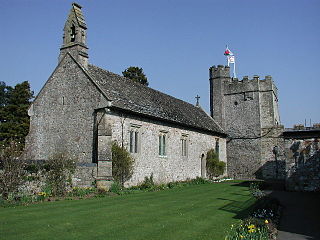
St Pierre is a former parish and hamlet in Monmouthshire, south east Wales, 3 miles (4.8 km) south west of Chepstow and adjacent to the Severn Estuary. It is now the site of a large golf and country club, the Marriott St Pierre Hotel & Country Club, which was previously a large manor house and deer park belonging to the Lewis family.

The Shire Hall in Agincourt Square, Monmouth, Wales, is a prominent Grade I listed building in the town centre. It was built in 1724, and was formerly the centre for the Assize Courts and Quarter Sessions for Monmouthshire. In 1839–40, the court was the location of the trial of the Chartist leader John Frost and others for high treason for their part in the Newport Rising. The building was also used as a market place. The Shire Hall is owned by Monmouthshire County Council and has audiovisual guides for visitors to Courtroom 1. It is currently used as a Tourist Information Centre and as the offices for Monmouth Town Council, and is open to the public in part.
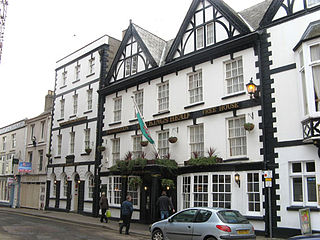
The King's Head Hotel is a hotel standing opposite the Shire Hall in Glyndŵr Street, Agincourt Square, Monmouth, Wales. It dates from the mid-17th century, and as one of the major inns in Monmouth was reputedly visited by Charles I of England in 1645. It has a fine black-and-white painted stone façade and became an important posting inn in the late 17th century, with a yard through an archway where visitors' horses could be stabled and where regular coach services called. In the 18th and 19th centuries, stagecoaches for London left from the inn. The range of buildings along Agincourt Street now includes the former Monmouth Bank and the County Club, while the inn itself is now part of the J D Wetherspoon pub chain. It is one of 24 buildings on the town's Heritage Trail and is a Grade II* listed building.
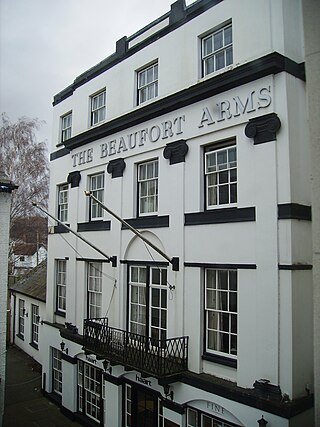
The Beaufort Arms Hotel, in Agincourt Square in the town of Monmouth, south-east Wales is a former coaching inn dating from the early eighteenth century. The frontage was modified in the 1830s, possibly by the prolific early Victorian architect George Vaughan Maddox. A stone cornice on the central block carries the inscription "The Beaufort Arms". A Grade II* listed building, it features in the Monmouth Heritage Trail. In the 20th century, the building was converted to residential apartments.

The Port Wall in Chepstow, Monmouthshire, Wales, is a late thirteenth century stone wall, which was constructed for the twin purposes of defence and tax collection by permitting users of the town's market only one point of access through the wall at the Town Gate. The wall originally formed a semi-circle extending for some 1,100 metres (3,600 ft), roughly southwards from Chepstow Castle to the River Wye. It enclosed an area of 53 hectares, including the entire town and port as it existed at that time. Substantial sections of the wall remain intact, and both the Port Wall and the Town Gate are Grade I listed buildings. The Port Wall is a Scheduled monument.
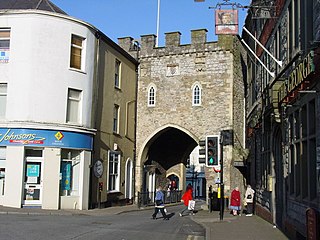
The Town Gate at Chepstow, Monmouthshire, Wales, known locally as the Town Arch, was historically the only landward entrance to the town through the Port Wall, and a point where tolls for those resorting to the town and its market were collected. It was originally built, with the wall, in the late thirteenth century. The current archway mainly dates from the sixteenth century, but has been restored and partly rebuilt on several occasions. It is located at the western end of the town's High Street, and is a Grade I listed building.

The Old Wye Bridge or Town Bridge at Chepstow, also known historically as Chepstow Bridge, crosses the River Wye between Monmouthshire in Wales and Gloucestershire in England, close to Chepstow Castle. Although there had been earlier wooden bridges on the site since Norman times, the current road bridge was constructed of cast iron in 1816 during the Regency period, by John Rastrick of Bridgnorth, who greatly modified earlier plans by John Rennie.

The Punch House is a public house and hotel located at Agincourt Square, Monmouth, Wales.

The Vine Tree is a public house situated in Monnow Street in the town of Monmouth, Wales. The building has been a Grade II Listed building since 18 November 1970.
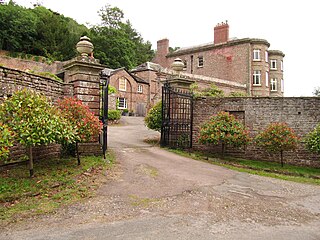
Newton Court is a neoclassical house, completed in 1802, situated on the hillside above Dixton, 1 mi (1.6 km) north-east of the town on Monmouth, in Monmouthshire, Wales. It is a Grade II* listed building. The stable block is listed as a Site of Special Scientific Interest (SSSI), noted for as a breeding site for lesser horseshoe bats.
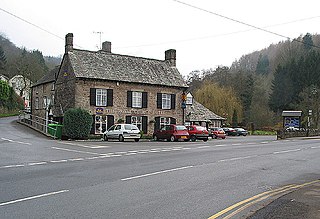
The Wild Hare Inn is a pub with rooms in Tintern located 5 miles (8.0 km) to the north of Chepstow, Monmouthshire, Wales. It is situated beside the A466 road, across the road from the River Wye, on the corner of an unclassified road to Devauden and Trellech. It is a Grade II listed building.
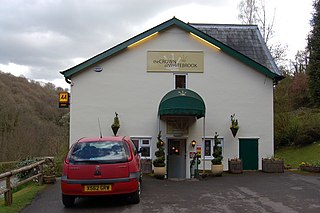
The Whitebrook, formerly known as The Crown at Whitebrook, is a restaurant with rooms in Whitebrook, 6 miles (9.7 km) south-south-east of Monmouth, Monmouthshire, Wales, near the River Wye and the border with England. The building is thought to date from the 17th century and by the 19th century it was used as a roadside inn. Its restaurant was run by Chef Patron James Sommerin until 2013; it gained a Michelin star in 2007. It contains eight double rooms and a 2-acre (0.81 ha) garden. On 7 March 2013, it closed because of financial difficulties; at the time it had the longest held Michelin star in Wales. Critics praised the food under Sommerin, but have criticised the difficulty in finding the restaurant. It re-opened in October 2013 under new chef and owner Chris Harrod, and regained the Michelin star in 2014. Harrod serves a menu using locally produced meat and vegetables along with foraged ingredients such as charlock, hedge bedstraw and pennywort.
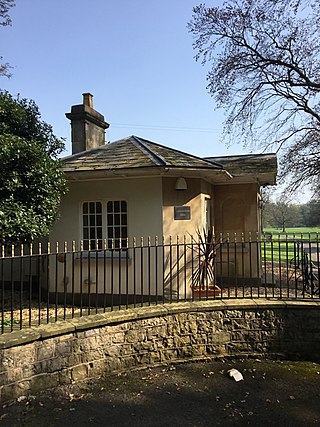
Wyelands, sometimes styled The Wyelands or Wyelands House, is a Grade II* listed building and estate located about 1 mile (1.6 km) north of the village of Mathern, Monmouthshire, Wales, United Kingdom and about 1 mile (1.6 km) west of the edge of Chepstow. It is a neoclassical villa designed by Robert Lugar in the late Regency period, and was completed around 1830. The park surrounding the house is listed on the Cadw/ICOMOS Register of Parks and Gardens of Special Historic Interest in Wales.





















